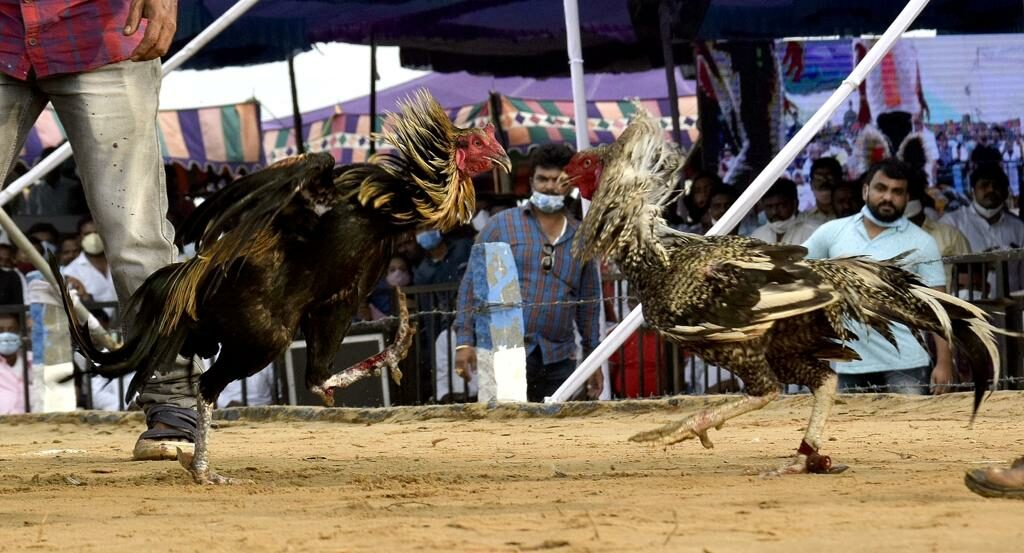After it was washed out for two years due to the pandemic, organisers of rooster fights are hoping for a bounty this year.

A cockfight in Andhra Pradesh. (Supplied)
Coastal Andhra Pradesh — particularly vast swaths in the Krishna and Godavari basins — is preparing for the bloody sport of cock-fighting, featuring fighter roosters known as “Pandem Kollu”.
After all, Sankranthi — the harvest festival — is just around the corner: It is celebrated every year on 14, 15, and 16 January.
Every year, it is estimated that at least 2 lakh fighting roosters entertain spectators during the three-day festival.
After it was washed out in the previous two years due to the pandemic-induced economic downturn, organisers of rooster fights are hoping for a bounty this year.
The roosters are trained and bred for almost a year prior to the Sankranthi festivities. The breeders feed the birds a nutritious balanced diet of millets, cereals, dry fruits, and minced mutton so that they can withstand attacks from opposing roosters and develop agility and robustness.
The roosters are also given stamina training: They are taken swimming at least twice a day — in the morning and evening — and they are also trained in jumps.
While there are no official records of when cock fights began in Andhra Pradesh, they have grown in popularity in both the Godavari and Krishna districts over the years.
What began as a form of entertainment during the three-day Sankranti festival has evolved into a gambling game.
Unofficial estimates suggest that at least ₹1,000 crore changes hands over the three days, with the majority of the money spent in and around Bhimavaram in the West Godavari district and Kaikaluru in the Krishna district.
Both are prosperous and wealthy areas of the Krishna and Godavari river basins.
The fights — between razor-wielding roosters with alert eyes and gleaming tails — often do not last long. In a short period of time, enthusiasts place bets on each of the roosters competing.
Despite the fact that the Supreme Court permitted cock fighting for entertainment while prohibiting the tying of knives and betting, the illegal activity continues unabated. And all of this occurs while the police are present.
Huge pandals with oversized LED screens are erected in places, and even casino setups are seen these days.
Ai Bhimavaram in the West Godavari district is one of the prominent places in Andhra Pradesh where high-stakes cockfights take place on a large scale on open grounds.
Each round of fighting in each of the 200 designated fighting rings attracts bets of ₹10 lakh.
At least 20 fights are scheduled in each ring every day over the three days.
“It’s part of our culture. It is only for three days after we worked all year. The three days are for enjoyment, and the main attraction is cockfighting. It gives you that adrenaline rush,” West Godavari resident Kumara Varma told South First.
On their part, the police dispatch special teams to seize the knives tied to the roosters’ legs to prevent bloody sport.
“In this regard, we can’t really control the activity over the three days. All we can do is stop the bloodshed by seizing the knives and preventing gambling from taking place,” said a senior police official from one of the former twin Godavari districts.
“How can we go against everyone when entire villages are engaged in cockfighting in the name of age-old tradition and culture?” he asked.
With the election just around the corner, politicians also have no choice but to organise these cock fighting events in their area.
Every year, politicians — ranging from sarpanches to ward members, from MLAs and ministers — sponsor such cockfighting events during Sankranthi as part of their “outreach” activities to woo the locals.
Though there are approximately 20-30 varieties of roosters used in cock fighting, five of them are in high demand: pacha, benaki dega, kaaki nemali, setu, and kaaki dega. These five varieties are well-known for their fierce fighting abilities.
These varieties range in price from ₹25,000 to ₹30,000 each. A fighting rooster that arrives at the weekly shandy markets a month before Sankranthi costs ₹6,000.
“In addition to providing a nutritious diet, we must care for and protect our roosters. There is also the possibility of sabotage. Opponents sometimes attempt to poison our roosters. When the birds are pushed into the ring, this sport can become a prestige issue,” said Sarath A from West Godavari, who bought a nemali dega rooster recently at the Gokavaram shandy market near Kakinada.
Cockfighting was prohibited in the state in 2014, thanks to the Prevention of Cruelty to Animals Act of 1960 and the AP Gaming Act of 1974. In 2018, the ban was reinstated.

Jul 26, 2024

Jul 26, 2024

Jul 26, 2024

Jul 25, 2024

Jul 24, 2024

Jul 24, 2024